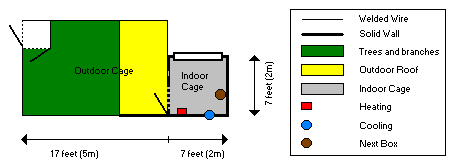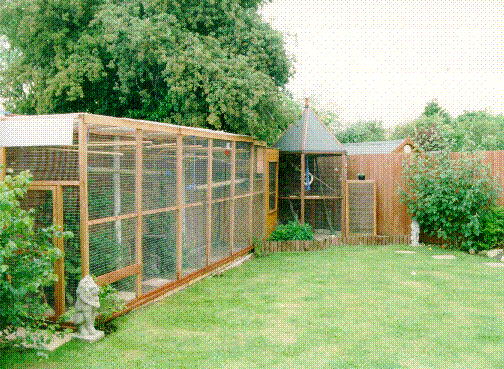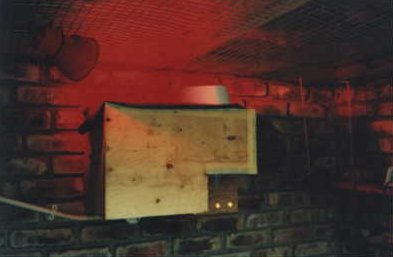A few important pointers realted to primate housing:
- The bigger the cage the better.
- If possible create an outdoor primate enclosure with (if needed) a heated indoor cage.
- A cage can never be secured enough, don’t underestimate the power of primates.
- When building your primate enclosure, keep safety in mind. Monkeys are very curious animals.
- A double entry door is not a luxery.
Many monkeys show signs of boredom in captivity, therefore it’s very important that you change their environment from time to time. Monkeys can spend many hours exploring their home. Try to use a lot of different items in their home.
A few examples* :
|
Outdoor Branches |
Indoor Branches |
(*) Visit our enrichment section for more idea on cage enrichment
You must clean indoor cages (at least) every week. Droppings and excess food should be removed daily. Some primates are known to scentmark their environment (like marmosets), for these monkeys it’s very imporant that you don’t sterialize their cage at once (clean the nestbox and the cage at different times). Use a mild desinfectant (you can buy this at your local pharmacist) to clean their cage.
When building an outdoor cage don’t forget to provide some shade in the summertime and protection from wind and rain (cover a part of the cage with a roof). Never use chicken wire. Depending on the specie use stainless steel welded wire (marmosets, tamarins, squirrels…) or chain link (capuchins, …). Don’t forget that monkeys like capuchins are very strong animals so a chain link of appr 12 gauge strength should be used. A safety entrance to prevent monkeys from escaping is certainly not a luxury.
Not only the width and length of a cage is important but also the height of the cage can be very important. Even small species like marmosets and tamarins prefer higher cages (they feel more secure), therefore it’s also very important that the next box is placed as high as possible. The minimum height of a cage for capuchins, guenons, macaques and even for marmosets and tamarins is about 6 feet high (1.80m), for squirrel monkeys the minimum height is about 5 feet high (1.50m).
Most primates need unfiltered sunlight (vitamin D3) for their skeletal development, so if you don’t have an outdoor cage maybe it’s more then a good idea to use Vita-Lites (replicate natural sunlight).
The choice of floor type is also very important. You can use a drop tray, peat, sawdust, straw, dried leaves or wood chip floors for smaller cages. Larger cages are probably better off with cement floors, floors covered with linoleum, kitchen or bathroom floors. Some people raise their cage high enough from the ground (wire bottoms) for easy raking cleanup underneath. This will also prevent a monkey from reaching for food or other items fallen onto the soil.
When creating a natural environment with lots of plants, don’t forget to use non-toxic plants! Here are a few examples of non-toxic plants : bamboo, rubber tree, willows, palm trees, elm, fig, hibiscus, pine, elder and silverberry. But watch out for toxic plants like American oak tree (european is ok), cedar, mistletoe and pencil tree.
Don’t forget to use branches in your in- and/or outdoor cage. Use branches from for instance salix, pseudoacacia or sambuncus trees. Natural gum is very rich in vitamin D and Calcium and therefore recommended for most primates. However beware in spring when the gum is young, it may cause intestine problems.
Examples:
Johan Mommens with marmoset monkeys.

This is an example of an outdoor enclosure with a heated indoor cage for marmosets. Although marmosets are rather small monkeys they prefer (like all monkeys) a big cage. 1/3 of the outdoor cage is covered with a roof to protect them from rain and heat. In the other 2/3 I created a little jungle with lots of trees for these little but fast creatures. This gives them the opportunity to explore, jump, run and hide themselves whenever they want. The outdoor floor is covered with leaves, the indoor floor is covered with peat so it doesn’t need to be cleaned daily.

Donna Dozier with a Java Macaque
I use dog runs for my indoor-outdoor cages with a doggie (or monkey) door in between. I’ve just added another 6 ft. extention to the outdoor cage. They are real sturdy and easy to put up. I just buy the panels and screw them together. The panels are chain link fencing.
Sony Rickson with several monkeys, esp capuchins
This are pictures of my outdoor cages, actually it is 5 cages linked together, all are 6x6x6′.




Here is a picture of the indoor cage in my bedroom

8X8X8′ cage – inside the cage: hammock, ropes, mirrors, puzzle feeder (from Primate Products) cat scratching post with hideout and a hay feeder sack (for horses) that they hide in and I also store their toys in it. On the side of the cage is a small locking access door that allows me to open and close the doggie door without getting in the cage. Jungle wall mural with actual portraits of my monks sitting in the trees, swinging from vines. There is a doggie dog in the entrance to the cave which goes out onto my balcony 20X30X10′ high. On the side of the indoor cage is a small locking access door that allows me to open and close the doggie door without getting in the cage. Outside there is a playhouse, more ropes, forage box, feeder tray and water bottles in built-in holders that lock. And of course, more toys!
Here is a picture of my water bottle holders, the top bar is hinged…

“And… here is J.P. Booger & Jessica using their food tray holder. Again, a door on the outside of the cage that locks with a padlock. No more tipped over food bowls! I made this big enough for a 9X14″ cake pan.”

Karl Ireland with Miga, his capuchin
Her cage is VERY HEAVY DUTY and is based around a 6′ x 10′ dog kennel kit purchased at Home Depot. This kennel kit is 6′ high, (now it is almost 7′ high), and includes a full size walk in door.
An IMMENSE amount of work went into this basic kennel to convert it from a floppy and roofless dog kennel into an extremely sturdy and secure primate habitat. Many custom needed to be designed from the ground up including the specialized door locking system (loosely based on a bank vault mechanism).
Where each of the original single vertical 6′ tubes are positioned, an additional 6′ tube is added and mounted close enough to leave only a 2″ gap between them. I might mention that each of the tube pairs are positioned exactly so they straddle, (one on each side), the slip-joints that connect all the horizontal tubes together that form the 2 identical 6′ x 10′ cage base and the 6′ x 10′ cage top.
The included single sheet of chain link fencing was not adequate for my new habitat’s design, so I separated and sized it into about 16 smaller pieces. I then used steel stretcher rods as a perimeter frame for each pre-sized pieces of chain link fence to be attached to while being stretched very tight both horizontally and vertically.
Next each of the framed chain link fence panels are positioned and mounted in the large open spaces that are separated by all the 6′ vertical tube pairs. This double tube arraignment allows the cage to be disassembled into 6 “fully assembled modules”. The roof section is also constructed in the same fashion and can be detached as 2 identical panels each measuring 6′ x 5′ in size.
The most tiring and time consuming chore involves mounting each of the small cut off pieces of chain link to the stretcher rod frames. The reason is that it is EXTREMELY IMPORTANT that as each solid wire is cut, bent and attached to the rods that ALL WIRE ENDS AND SHARP EDGES MUST BE FORMED & BLUNTED & POSITIONED SO THAT THE MONK IS UNABLE TO COME IN CONTACT WITH ANY THING SHARP, JAGGED, POINTED OR QUESTIONABLE to eliminate the chance of being cut or worse, blinded while he is playing, swinging etc. in his enclosure. Monks play rough and fast so nothing dangerous should be available to him that might possibly cause injury if contact is made during his activities inside the enclosure. Each wire end, bolt head, nut etc. is different and usually requires a different procedure as to mounting position, bending or forming during the cages design & construction. I have spent countless hours inside the cage using my hands to contact every surface, bolt, nut etc. from many different angled looking for anything that feels sharp or pointed or otherwise might make my hand feel any discomfort whatsoever. I had to think like a monkey at play, and also think like a human being to try with all my ability to find something that even under the most unusual circumstances might cause an injury to him.
So in a nutshell the whole cage can be broken down into just (6) wall sections, (1) door section, and (2) roof sections, all by removing only (18) 1/4-20 bolts! The cage could, for example, be taken to a quarter car wash for cleaning, or a friend or monkey sitters location to be cared for while keeping the monk in his own familiar home.
The cage base’s steel perimeter tubing is actually raised an additional 3″ above the cement by 6 small support tubes. This additional feature keeps the tubing off the cement so any accumulated dirt & debris will not collect at and under the tube where it would be difficult to remove. This also allows me to sweep UNDER the cake from the outside to the inside! The water hose can also be used to squirt dirt and stuff without the cage being in the way. It is like having 6 strong men lift the cage when I need to clean it. I might mention that I measured Miga’s body parts including chest, shoulders, and most importantly his skull size with a dial caliper to get exact sizes. These measurements allow me to set the length of the cage “stilts” to keep them as long as possible for ease of cleaning while not presenting either the skull or shoulders the necessary clearance for Miga to escape through. Having a cage like this is ideal because I can clean it from inside or outside all while he continues to play inside. Also a walk in cake allows the monkey dad or monkey mom plenty of room to chase and be chased or wrestle with the beast comfortably for many hours and still include enough space for any large items for you and him to play with.
I have only 1 color camera in use now, but I am going to add 2 more cameras to provide an additional view of his inside cage and another to view the tunnel system.
First I have to design a motion detector system that use infra-red motion sensors to see if Miga is in his (1) big outdoor cage, (2) smaller inside cage, or (3) the tunnel system connecting all the cages. The detector will see him in the big cage and enable camera #1 to view the big cage. If he decides to travel to the inside bathroom cage, his entry into the tunnels will trigger the tunnel motion sensor (which only views the tunnels) and thereby cause the big cage camera view to be replaced with the tunnel camera view. Once he get to the inside bathroom cage the tunnel camera view is replaced by the camera viewing the inside cage. All this will be done with 3 cameras, 3 Radio Shaft infra-red motion detectors and a homemade video switcher that will route the selected cameras video to the video capture board in my desktop DX2 486-66 computer which runs the video server. This machine automatically logs on the web at 10am. At 6pm all camera video is turned off and the server program selects a pre-recorded AVI video of my choosing which usually shows Miga and I wrestling and playing in the living room or something better with Miga.
Gordon Lawless with several marmosets
My Monkey House is 28 feet long in all. It has a heated area in the pointed bit, where they sleep. At the moment there is 3 Cotton Topped Marmosets in there, one male and 2 females.

Marlene Bezuidenhout with several tamarins and marmosets
The Cages have 3 heating systems : heatpads, globes and infra red lamps.


Send us pictures and descriptions of your indoor and outdoor enclosures so we can share them on our site!
Browse In The Primate Diet
April 5, 2017 9:48 am
By Janice Metzger

“Browse”, as it relates to primate diets, is plant material such as leaves, vines, berries, twigs and even branches. Wild-living primates consume many types of plant materials that are native to the regions in which they live. Browse is an important part of our captive-living primates’ diets as well. Though we do not have access to the native plants of our primates’ ancestral homes, many common plants in the U.S. are suitable to be fed as browse to our primates.
Browse supplies more fiber than even the high-fiber commercial biscuits, and more fiber than many of the vegetables that we feed to our primates. Fiber is an essential element in our primates’ diet as their “gut,” or intestinal tract utilizes fiber to properly digest and metabolize the food they eat. Primates need substantially more fiber in their diets than humans do. Not only does browse supply essential fiber, but is also a source of enrichment as our monkeys explore and manipulate the plant materials; picking the leaves and berries off the stems and stripping the bark from the branches.
Monkey Proofing your House
February 15, 2012 6:33 am

Many primate owners allow their monkey to run around in the house for short periods of time since it provides great exercise. Before doing so, it is important to monkey proof your house as much as possible.
Due to the speed monkeys are able to move, it only takes a few seconds for your monkey to get into trouble so it is important you keep an eye on them at all times. While it might be very difficult to monkey proof your entire house, you can monkey proof certain rooms. The only room that is rather hard to monkey proof is the kitchen. It isn’t the first time a monkey gets burned from the stove top or by leaping into a pot of boiling water. While the kitchen should truly be of limits, you most certainly should not be cooking while your monkey is in the room. Many species are able to turn the stove handles so if your monkey is allowed to be in the kitchen, it is recommended you take the handles off and store them in a drawer.
Be carefull with appliance cords. Your monkey might pull on them and if they get in contact with the current, it will most likely result in death. It is also recommended to use child proof safety covers where you need to twist the plugin before you can make contact. If your monkey remains unattended in a room with plugins, it is highly recommended to cover them completely.
Posted in housing